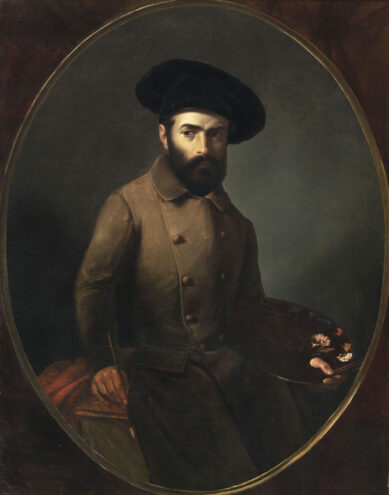(Milano 1815 – 1860)
Portrait of the painter Carlo Bellosio
Measures: 122 x 95 cm
Technique: oil on canvas
Notes: a similar version of this portrait is preserved in the Galleria d’Arte Moderna, Milan
Provenance: heirs of Giambattista “Titta” Torelli (a Milanese collector, friend of Giuseppe Ricci Oddi; his Neapolitan cousin Luigi Torelli
A painter and decorator from Lombardy who was particularly popular in the mid-19th century in the Milanese area, Mauro Conconi is one of the main protagonists of the transition from a classicist language to a markedly Romantic vision.
After executing important decorative cycles between Turin and Milan in the 1830s and 1840s, the artist worked on easel painting: expressing himself with historical and literary subjects in which a refined and loose Romanticism with pure colourism emerges, resembling that of Francesco Hayez (1791-1882) and gradually moving away from the academic rigour of his Braidense maestros Luigi Sabatelli and Carlo Bellosio (a painter with whom he collaborated until 1842): “… and especially in his last years, his mind, as it took flight more freely, allowed his works to be infused with a dramatic sense and a contemplative aura, unlike the model of Bellosio”[1]. One of his most significant portraits is that of the painter Carlo Bellosio, included by the biographer Giuseppe Mongeri – a close friend of Conconi’s – among the works he executed in 1850, which was described as a “Portrait of the painter Carlo Bellosio, done from memory”[2]. There are two variants of this subject: the one presented here, originally belonging to the Milanese collector Torelli, a friend of Giuseppe Ricci Oddi and brother of Eugenio Torelli-Viollier (founder of the “Corriere della Sera”), and the slightly larger one preserved in the Galleria d’Arte Moderna in Milan.
It was acquired by the museum in 1902 as a loan from the Pinacoteca di Brera, and was exhibited in the annual Braidense competition in 1852. In the exhibition catalogue, Conconi was included in the portrait painters section together with Andrea Appiani: “Mauro Conconi and Andrea Appiani exhibited some portraits executed with true mastery and rare transparency of colour”[3]. The canvas presented here shows some significant differences with the painting preserved today in the Galleria d’Arte Moderna in Milan, and this makes it a unique and particularly interesting variant. First of all, the colour range used by Conconi to depict his maestro in an oval as he is holding a palette (which is round here and rectangular in the Milanese version) in his left hand and a paintbrush in his right, is more vivid. In the painting preserved in Milan Bellosio is wearing gloves, whereas here his hands are bare, and his face is covered by a beard; he looks less serious and frowning, perhaps just pensive, and is largely illuminated by a seductive grazing light that shows him in a fascinating guise, somewhere between the romantic hero and the Biedermeier-style man – as Conconi himself wrote in a letter sent to Mongeri, while they were decorating the royal villa in Pollenzo: “…truly indefatigable; if you saw how much he had already done in such a short time, you would be astonished”[4]. There are further details and colours in the oval, the painter is in fact standing on a stool covered with a green cloth that contrasts with the red drapery. Bellosio is also standing out against a dark background that is illuminated just over his left shoulder, giving character and depth to the painting (whereas in the museum version the background appears lighter and two-dimensional). A masterpiece of 19th-century portraiture, between formal sensitivity and psychological investigation, the canvas can be likened for its similar chromatic and spiritual vigour, to the coeval Portrait of Giovanni Juva, his collector – which links him indissolubly to Francesco Hayez, who shortly afterwards would create a pendant portrait of his wife, the singer Matilde Juva Branca. “In the moods of the heads, in the features of the faces, in the motion of passions and thoughts, in the attitude of the figures and even in the clothes, he succeeded in imprinting and expressing a powerful yet natural life, a bold yet spontaneous language, movements that were studied but without artifice”[5].
[7].
Elena Lago
[1] G. Mongeri, Mauro Conconi pittore, 1815-1860, Milan, 1861, p. 16.
[2] Ibidem, p. 62.
(Mongeri writes about portraits in Conconi’s production: “In such an artist’s life, the art of the portrait is but an incident of little importance and, I would say, not at all transitory: although he was also familiar with this genre, and left more than one beautiful one, however quickly marked…”, p. 41.)
[3] Esposizione di Belle Arti in Milano, 1852, p. 161
[4] G. Mongeri, p. 13.
[5] G. Merziario, I maestri Comacini. Storia artistica di mille duecento anni, Milan: Giacomo Agnelli, 1893, p. 176.





